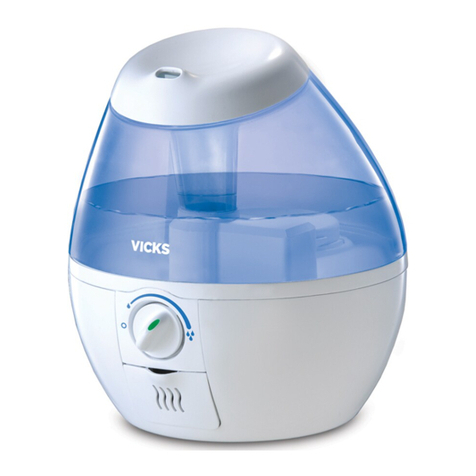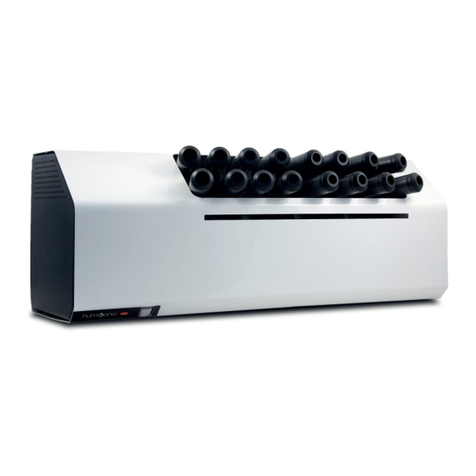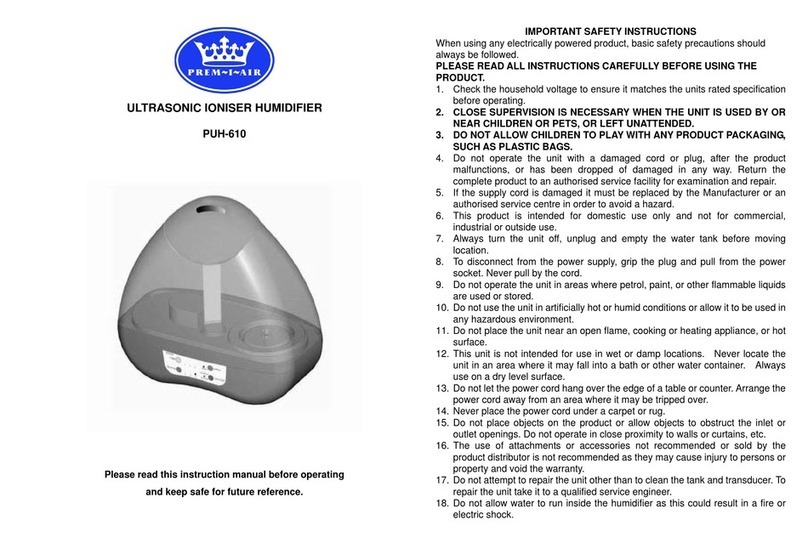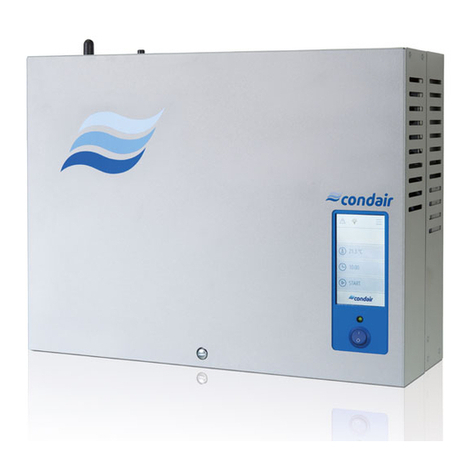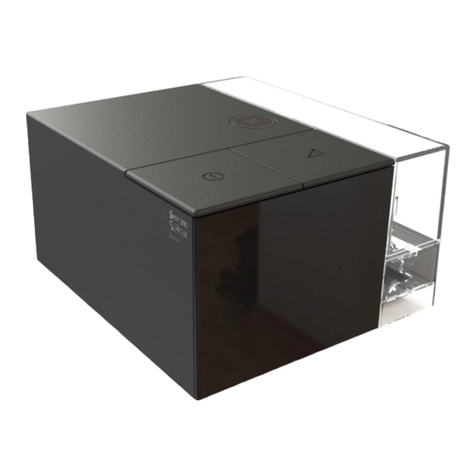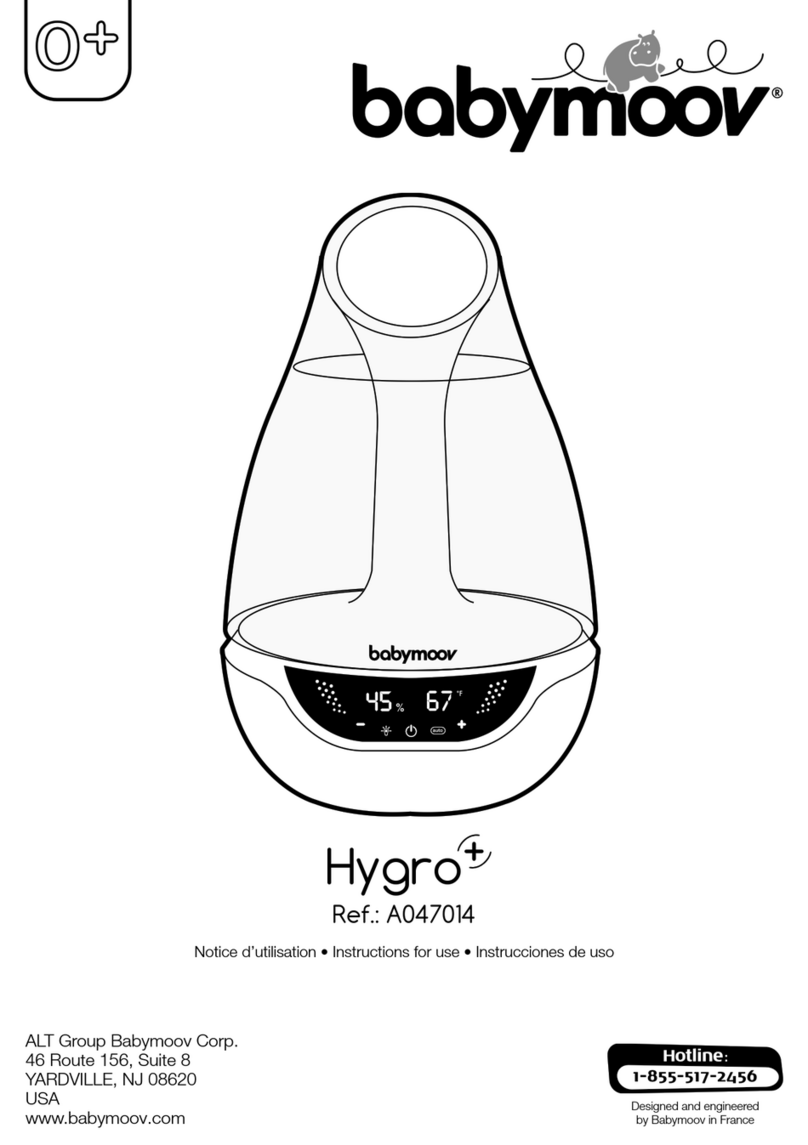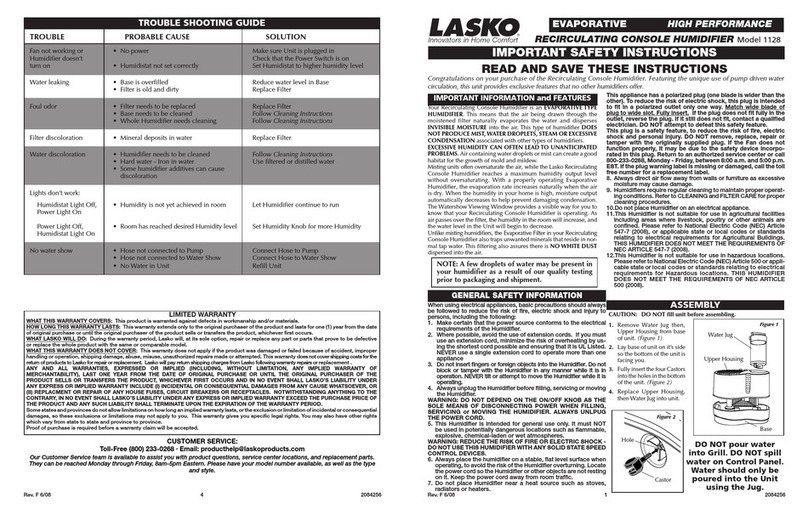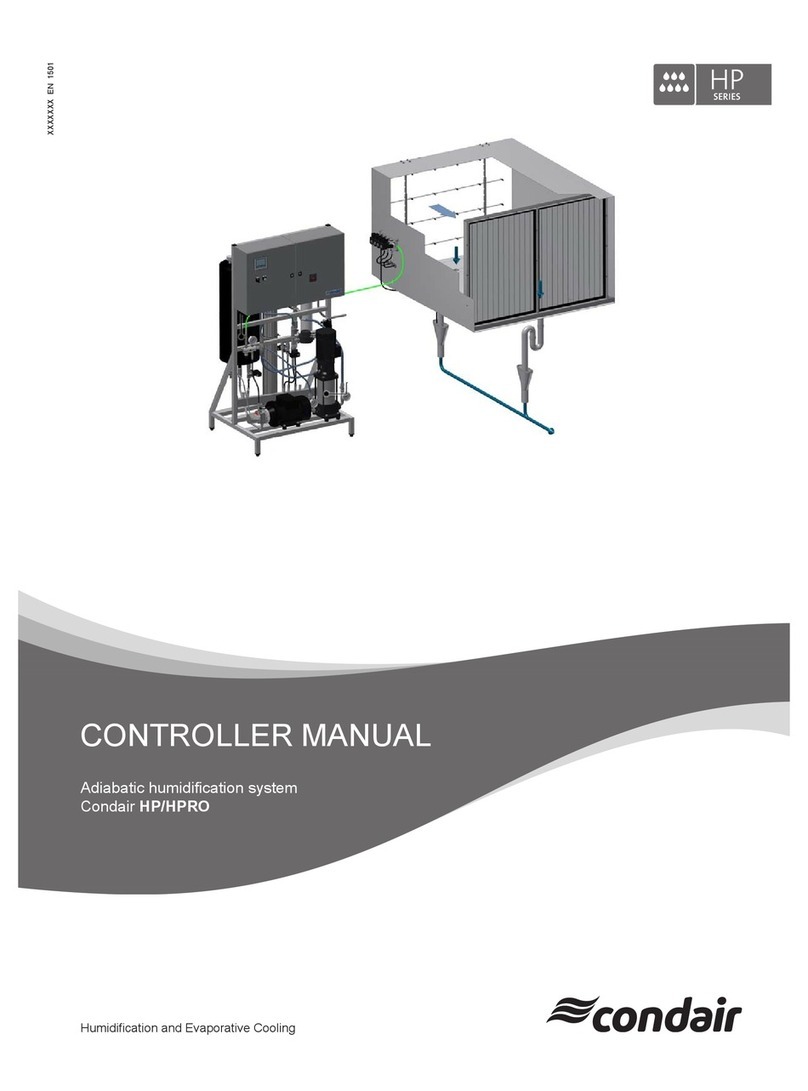GGM VH-2600 User manual

GGM
Respiratory Gas Humidifier
VH-2600/VH-2600A
Respiratory Gas Humidifier
Technical Manual
REV A 2017/06/09
Manufacturer: Great Group Medical Co., Ltd.
Address: No.168, Xingong 2nd Rd., Tianzhong Township,
Changhua County 52046, Taiwan (R.O.C.)
Tel: +886.4.8758181 Fax: +886.4.8756161
E-mail: info@greatgroup.com.tw
Web: www.greatgroup.com.tw
ISO 13485 / CE 2460 / GMP

1
Manual Revision History
REVISIONE
DATA
DESCRIPTION
REV A 2017-06-09 RELEASE
NOTE:
1. Great Group Medical Co., Ltd. has a policy of continued product improvement and reserve the right to
change specifications without notice.
Revision History
VH/2600/VH-2600A humidifier. firmware and hardware version of the record as shown in the table.
Operation of the machine should pay attention to the use of version, the version of the operation may be
different.
VH-2600
PCB Version Data Serial number DESCRIOPTION
P:BC23024F12210
D:BC31013A12210
YY MMPXXX
YY MMDXXX P:2014/03
D:2012/11 GGCVV CC YY MM XXX New issue
VH-2600A
PCB Version Data Serial number DESCRIOPTION
P:BC23024F12210
D:BC31013A12210
YY MMPXXX
YY MMDXXX P:2014/03
D:2012/11 GGDVV CC YY MM XXX New issue
Description: YY:Year;MM:Month;XXX:serial number;VV:voltage;CC:country。
VH-2600
Version DESCRIOPTION Date
V2.00 New issue 2010/11
V2.10 Added Heater Wire low impedance detection. 2011/01
V2.22 Added RS-232 debug function. 2011/06
V2.24 Revise Airway temp Low Alarm of the mute time from 3
to 10 minutes. 2011/09
VH-2600A
Version DESCRIOPTION Date
V1.00 New issue 2012/04
V1.01 Chamber temp setting range 36~40 change to 34~40 2012/09

2
Contents
Manual Revision History...................................................................................................................................1
Revision History ................................................................................................................................................1
1. Introduction....................................................................................................................................................4
1.1. About This Manual .............................................................................................................................4
1.2. Glossary..............................................................................................................................................4
1.3. Definitions...........................................................................................................................................5
1.4. Product Application ............................................................................................................................5
1.5. Humidifier Symbol definition.............................................................................................................6
2. Product Specifications ...................................................................................................................................6
2.1. Mechanical..........................................................................................................................................6
2.2. Electrical Rating..................................................................................................................................6
2.3. Temperature Control Range:...............................................................................................................6
2.3.1. Temperature .............................................................................................................................6
2.3.2. Alarm Parameters:....................................................................................................................7
2.4. Performance........................................................................................................................................7
2.5. Operating, Transport and Storage Environment.................................................................................8
2.6. Standards Compliance ........................................................................................................................8
3. Explanation of Controls and Indicators .........................................................................................................8
3.1. Humidifier Operation..........................................................................................................................8
3.2. Power on Self-check...........................................................................................................................8
3.3. Front Panel..........................................................................................................................................9
3.4. Display..............................................................................................................................................11
3.5. Flow Chart ........................................................................................................................................12
3.5.1. Flow Chart for VH-2600........................................................................................................12
3.5.2. Flow Chart for VH-2600A.....................................................................................................13
4. Maintenance Schedule.................................................................................................................................13
4.1. Maintenance Schedule......................................................................................................................13
4.1.1. Humidifier..............................................................................................................................13
4.1.2. Temperature Probe.................................................................................................................14
4.1.3. Heater Wire Adapter ..............................................................................................................14
4.1.4. Mains Plug.............................................................................................................................14
4.1.5. Safety .....................................................................................................................................15
4.1.6. Breathing Circuit....................................................................................................................15
5. Alarm and Troubleshooting..........................................................................................................................15
5.1. Alarm Indicator.................................................................................................................................15
5.2. Troubleshooting ................................................................................................................................17
5.2.1. Low Temperature...................................................................................................................17
5.2.2. High Temperature ..................................................................................................................17
5.2.3. Temperature Fluctuating........................................................................................................17
5.2.4. Excessive Water in Circuit.....................................................................................................18

3
5.2.5. Low Humidity........................................................................................................................18
5.2.6. Alarms....................................................................................................................................18
5.2.7. Temperature Display..............................................................................................................19
5.2.8. Breathing Circuit Leak...........................................................................................................19
5.2.9. External Water Leak...............................................................................................................19
6. Servicing Procedures ...................................................................................................................................20
6.1. General Precautions..........................................................................................................................20
6.2. Disassemble ......................................................................................................................................20
6.2.1. Opening the Case...................................................................................................................20
6.2.2. Replacing Fuses.....................................................................................................................21
6.2.3. Resetting the Thermal Cutout................................................................................................22
6.2.4. Replacing the Mains Cable....................................................................................................22
6.2.5. Replacement of Printed Circuit Boards (PCBs).....................................................................23
6.2.6. Replacing the Termistor.........................................................................................................23
6.2.7. Checking the heater plate element.........................................................................................24
6.2.8. Replacing the Thermal Cutout...............................................................................................25
6.2.9. Closing the Case ....................................................................................................................25
7. Performance Testing ....................................................................................................................................26
7.1. Humidifier Performance Testing.......................................................................................................26
7.1.1. Humidifier Calibration Check................................................................................................26
7.1.2. Humidifier Display Check.....................................................................................................26
7.1.3. Humidifier Voltage Calibration Check ..................................................................................26
7.1.4. Humidifier Warm-up and Control Check...............................................................................26
7.2. Humidifier Warm-up and Control Check..........................................................................................26
7.3. Temperature accuracy calibration.....................................................................................................26
8. Recommended Maintenance Checklist........................................................................................................27
8.1. Humidifier Check (Annually)...........................................................................................................27
9. Exploded Diagram.......................................................................................................................................27
9.1. Heater Plate.......................................................................................................................................27
9.2. VH-2600 Exploded Diagram............................................................................................................28
9.3. VH-2600A Exploded Diagram..........................................................................................................28

4
1. Introduction
1.1. About This Manual
This manual is intended for qualified service personnel who will perform maintenance and servicing on the
Great Group Medical Co., Ltd. VH-2600/VH-2600A Respiratory Humidifier. This manual covers the
product specifications, includes a maintenance schedule, and provides the necessary information required for
servicing.
NOTE: Some software may not be available in your country. Refer to your local Great Group Medical Co.,
Ltd. representative for the appropriate software version. Maintenance procedures should be carried out at
regular intervals (as recommended in the maintenance schedule 8), to ensure that the humidifier and its
accessories are working correctly.
If a fault should occur with the humidifier, follow the troubleshooting guide (section 5.2) in order to find the
most likely cause. If the unit requires servicing, make sure the servicing procedures are followed in order to
prevent damage to the humidifier. After service, or as part of the maintenance schedule, a humidifier
performance check should be completed.
Due to the nature of the electronics contained within this humidifier, it is not recommended that the printed
circuit boards be serviced at component level.
1.2. Glossary
Chamber
Device that allows gas to be to be heated and humidified by passing it over heated
water.
Temperature Probe Sensor assembly for measuring gas temperature.
Airway Probe Sensor assembly for measuring gas temperature at the end of the inspiratory limb.
Chamber Probe
Sensor assembly for measuring gas flow and temperature at the outlet of the
humidification chamber.
Thermistor Atemperature sensitive resistor placed inside the chamber and airway probes.
Chamber Set Point The humidifier is expected to remain at chamber temperature.
Airway Set Point The humidifier is expected to remain at airway temperature.
Heater Wire Adapter Electrical connector between the breathing tube and the humidifier.
Breathing Circuit Tubing that carries respiratory gases to and from the patient.
Dual heated
Breathing Circuit Wire inside the breathing circuit which heats the respiratory gases.
Single heated
Breathing Circuit Wire inside the inspiratory tube which heats the respiratory gases.
PCB Printed Circuit Board.
Heater Wire Wire inside the breathing tube which heats the respiratory gases.
Inspiratory Limb The section of the breathing circuit that takes the inspired gases to the patient.
Expiratory Limb The section of the breathing circuit that takes the expired gases to the patient.

5
1.3. Definitions
NOTE: Possible be misunderstood or ignored the steps, to provide additional information.
Warning: indicates that a situation may occur which is potentially harmful to the patient or user.
Caution: indicates a condition that may lead to equipment damage, malfunction, or inaccurate operation.
1.4. ProductApplication
The unit is humidifier for hospital in the Intensve Care Unit (ICU). It’s used to provide humidity by
breathing circuit or mask for the patient.
Please refer to the list of Respiratory Humidification Products or local Giant Medical Materials Great Group
Medical Co., Ltd. for a list of approved accessories.
Warning:
The use of breathing circuits, chambers and other accessories which are not authorized by GGM may
cause malfunction, damages or injuries.
Make sure the invasive mode is set for patients having bypass airways.
The unit’s power cord only be connected medical grade power socket.
Before servicing, always disconnect the supply.
When installing the humidifier close to the patient, make sure that the humidifier is securely fastened
and lower than the patient.
Know adverse effects on the performance and safety of the humidification system when exposed to, for
electro cautery, electro surgery, defibrillation, X- ray (gamma radiation), infrared radiation, conducted
transient magnetic fields including magnetic resonance imaging (MRI), and radiofrequency
interference.
Make sure the temperature probes are connected correct.
The user must check safety performance of the unit, to ensure its complete work function well.
Make sure the power supply is stabilize.

6
1.5. Humidifier Symbol definition
Type BF
Consult instruction
for use
Caution Consult
accompanying
Drip Proof
Alternating
Current
Warn Electrical
shook hazard
Warn Surface
temperature
Ground Protection On (Power) Off (Power) Do not reuse Do not throw
away
Notified Body
2. Product Specifications
2.1. Mechanical
Dimensions: W135mm x D170mm x H156mm (without chamber fitted)
Weight: 2.9 kg (without a chamber fitted)
2.2. Electrical Rating
Model Number Supply Voltage Supply Current
VH-2600-115
VH-2600-230
VH-2600A-115
VH-2600A-230
AC 115 V
AC 230 V
AC 115 V
AC 230 V
2.0 A Max
1.0 A Max
2.0 A Max
1.0 A Max
Supply Frequency: 50 / 60 Hz
Heater Plate Capacity: 150W, maximum temperature 110°C
Heater Wire: 60W Max
Heater Wire Supply: 22 ±3 V~
Safety protection
Over current protection: 115V/3A (fast burn type); 230V/1.5A(fast burn type).
Over heat protection : 115±3°C thermostat (manual rest type).
2.3. Temperature Control Range:
2.3.1. Temperature
Display: 4 digit 14 segment LED
Range: 5.0 to 80.0°C, Accuracy: ±0.3°C (in 25.0 - 45.0°C temperature range)

7
VH-2600
Airway set Point: 31 - 40
°
C (default 39
℃
)
Chamber set Point: 31-40°C(default 37℃, limited toAirway set Point -5 to +2℃)
VH-2600A
Heater Wire Circuit
Invasive mode
Airway Set Point:36~40 (default:40°C)
Chamber Set Point:36~40 ( default :37°C)ver1.00
Chamber Set Point:34~40 ( default :37°C)ver1.01
Non –Invasive
Airway Set Point:31~35 (defaul:34°C)
Chamber Set Point:31~35 (default :31°C)
Non-Heater Wire Circuit:
Invasive mode: Airway Set Point:36~38 (default:37°C)
(chamber temperature limited to 66 °C)
Non –Invasive: Airway Set Point:30~32 (default :31°C)
(chamber temperature limited to 66 °C)
2.3.2. Alarm Parameters:
Heater Wire Circuit:
- High Airway Alarm: An immediate, audible alarm at a displayed temperature of 41°C or if the airway
temperature exceeds 42°C.
- Low Airway Alarm: An audible alarm between 10 minutes @29.5°C, and 60 minutes @34.5°C
- High Humidity Alarm: An audible alarm if the humidity temperature exceeds 41°C.
- Low Humidity Alarm: An audible alarm between 10 minutes @26°C.
Non-Heater Wire Circuit:
- High Airway Alarm: An audible alarm if temperature exceeds 41°C
- Low Airway Alarm: An audible alarm if temperature descends @29.5°C in invasive mode, or @26°C
non-invasive mode
- High Humidity Alarm: Light will twinkle but no alarm if the humidity temperature exceeds 66°C.
- Low Humidity Alarm: An audible alarm between 10 minutes @26°C.
2.4. Performance
Recommended ambient temperature range: 18-26°C.
Recommended Flow Range:
Invasive Mode: up to 60 L/min, Noninvasive Mode : up to 120 L/min.
Refer to breathing circuit specifications for minimum flow.
Humidity Performance: Invasive Mode: > 33 mg/L, Noninvasive Mode: > 10 mg/L.
Warm-up time: Less than 30 minutes.
Maximum Operating Pressure: 20 kPa, gas leakage at max. pressure < 50 mL/minute.

8
2.5. Operating, Transport and Storage Environment
Operating Transport Storage
Temperature 18- 26°C(64.4-78.8°F) -10- 50°C (14-122°F) -10- 50°C (14-122°F)
Relative humidity
30
%
-75
%
30
%
-95
%
30
%
-95
%
Atmospheric
pressure 70kPa-106kPa 50kPa-106kPa 50kPa-106kPa
Altitude 0-3000m(9000ft) 0-3000m(9000ft) 0-3000m(9000ft)
2.6. Standards Compliance
Safety requirements of IEC60601-1, IEC60601-1-2
Design requirement of ISO8185
Electric Shock Protection: Class I
Applied Part type BF
Water proof and Drip proof: IPX1
3. Explanation of Controls and Indicators
3.1. Humidifier Operation
This unit is designed to add heat and moisture to respiratory gases. The gas is passed through a
humidification chamber where it is warmed and humidified.
This unit has two heating systems. The first is a heater plate, which heats the water contained in the
humidification chamber, humidifying the air passing through it. The humidifier monitors the temperature of
the gas at the chamber outlet with the chamber probe, and controls the amount of power delivered to the
heater plate, in order to maintain the chamber set point.
Under normal conditions the gas is heated to 37 °C in the invasive mode, 31 °C for the noninvasive mode.
3.2. Power on Self-check
The purpose to internal inspection when turn on the unit.
Program of Power on Self-check:
1. Check the heater wire fuse is well.
2. Check the heater plate over heat.
3. Check the heater plate temperature probe open or short.
4. Check the heater wire adapter open or short.
5. Check the airway temperature probe open or short.
6. Check the chamber temperature probe open or short.
7. Check the heater wire open or short.
Visual / Audio Test Sequence:
The LED will light up and the 15-segment display will flash and the buzzer will be given Be-Be When the
power switch is on.

9
3.3. Front Panel VH-2600
When this button is pressed power to the heater wire is turned on and the green indicator
light will be illuminated. For non-heated wire circuits, the indicator light must be off. An
alarm will occur if the heater wire function is turned off while a heated wire circuit is
connected.
To adjust the set temperature Up, each press of adjustment 0.5 ℃.
To adjust the set temperature Down, each press of adjustment 0.5 ℃.
To select the parameter to display “Airway” to ”Chamber”.
Mutes all audible alarms.
Normal mute time is 3 minutes. The alarm condition indicator
lights will continue to flash until the condition is rectified.

10
VH-2600A
1. Locked / Unlock
*System will automatic “Lock” the panel after 60 sec when power on, and display the
chamber temperature.
*Hold FUNCTION for 3 sec => Unlock
*Hold FUNCTION for 3 sec => Lock
【The system will relock automatically after 60 sec, if there is no more operation.】
2. Exchange Temperature
1. Heater Wire Mode:
The system will automatically swift to “Heater Wire Mode”, when the system equipped
with heater wire while power on. System will swift to “Non-
Heater Wire Mode” after
holding MODE 3 sec.
2. Patient Mode
*In Patient Mode, button will be locked after 60 sec when power on.
*After power on, it is in “Invasive” Mode.
*Hold FUNCTION for 3 sec + Push MODE1 times and system will swift to
“Non-Invasive” Mode.
Will silent all alarm sound for 3 min, the alarm indicator will keep on flashing until the
alarm situation improved.
Invasive mode
Heater Wire Mode:Airway 40°C;Chamber 37°C。
Non-Heater Wire Mode:Airway 37°C;Chamber≦66°C。
Non-Invasive mode
Heater Wire Mode:Airway 34°C;Chamber 31°C。
Non-Heater Wire Mode:Airway 31°C;Chamber≦66°C。

11
3.4. Display
In generally condition: Display the actual temperature of gas being delivered from the chamber or the airway
temperature.
Symbols:
A40.0 Airway temperature A=40 Airway temperature set point
C37.0 Chamber temperature C=37 Chamber temperature set point
H100 Heater plate temperature ER.01 When heater wire short.
LOCK Button is lock UNL.K Button is unlock
A.OPEN When airway probe is
abnormal (opening). A.SHT When airway probe is
abnormal (disconnection).
C.OPEN When chamber probe is
abnormal (opening). C.SHT When chamber probe is
abnormal (disconnection).
H.OPEN When heat plate probe is
abnormal (opening). H.SHT When heat plate probe is
abnormal (disconnection).
N-HW Without heat wire mode. R<55 Sum of Insp. & Exp. Heater
wire resistance <5.5Ω.
OPEN When airway and chamber
probe is abnormal (opening). A-CS Airway or Chamber
temperature
AHI Airway temperature too high ALO Airway temperature too low
CHI Chamber temperature too high CLO Chamber temperature too low
HHI Heater plate temperature too
high HLO Heater plate temperature too
low

12
3.5. Flow Chart
3.5.1. Flow Chart for VH-2600

13
3.5.2. Flow Chart for VH-2600A
4. Maintenance Schedule
Keep routine maintenance to ensure safety for continuous usage.
4.1. Maintenance Schedule
It is necessary to avoid pollution by checking facilities and parts regularly. It is suggested contact with in
local for maintenance every 12 months.
NOTE: Keep routine maintenance to ensure safety for continuous usage.
4.1.1. Humidifier
The outer case of the unit is made of plastic. DO NOT use antiseptic liquid or sharp stuff to clean it.
Cleaning
It should turn off the power before cleaning.
Clean the humidifier with recommended disinfectants using a damp cloth: must be used 75% Isopropyl
Alcohol.

14
Wipe the humidifier clear of any cleaning residues before use.
1. Disconnect the humidifier from any electrical outlet.
2. Clean the humidifier with one of the following recommended disinfectants using a damp cloth:
a. Isopropyl Alcohol
b. Normal dishwashing detergent
NOTE: Follow the manufacturer’s instructions carefully.
NOTE: Use the correct dilution of the disinfectant.
NOTE: DO NOT immerse the humidifier in any liquid.
3. Wipe the humidifier clear of any cleaning residues before use.
4.1.2. Temperature Probe
The cleaning methods listed below comply with FDAregulations for these types of equipment and do not
affect the integrity or performance of the temperature probe.
Please contact your local dealer for suggestions on other cleaning methods not mentioned here.
1. Clean the probe and remove all visible contaminants by physically.
2. Use the following solutions to sterilize the temperature probe:SporicidinTM
、SporoxTM
、CidexTM
、CidexTM
OPA or Ethylene Oxide sterilization. The temperature probe was sterilized at 55 ° C (131 ° F) and 80 kPa,
allowing the remaining ETO to evaporate at least 15 hours before use.
NOTE:Please follow the manufacturer's instructions. Use the correct dilution disinfectant.
Warning:Do not immerse the connector plug in the disinfectant.
Do not use autoclaves.
Do not use detergent or solvent.
3. Wipe the patient end temperature probe before use
4. Stored in a clean environment.
4.1.3. Heater Wire Adapter
Clean the heater wire at with one of the following recommended disinfectants using a damp cloth:
a. Isopropyl Alcohol
b. Normal dishwashing detergent
4.1.4. Mains Plug
If the mains plug detachable design, check whether the screw is locked or not.

15
4.1.5. Safety
The resistance to earth from protectively earthed parts in the unit shall be low enough to permit adequate
fault current to flow in the event of insulation failure, thereby ensuring that the protection device in the final
sub-circuit opens quickly.
The protective earthing conductor also ensures that most of the capacitive leakage current from the mains
part in the unit flows via a low-resistance path to earth and does not appear as excessive leakage current
from the device enclosure or as Applied Part current, when the earthing conductor is intact.
The housing using plastic insulation material and the heater plate plating the insulating anodizing layer.
Protect of any person from electric shock hazards.
The value of their earth leakage current tested prior to commissioning and at regular intervals during their
service life. The mains plug and any part that is protectively earthed shall not exceed 0.2 Ωas shown in
Figure. (Refer to IEC/EN 60601-1 §8.6.4)
4.1.6. Breathing Circuit
Breathing circuit is a single use when you use a period of time or dirty, please replace the new product
directly.
5. Alarm and Troubleshooting
5.1. Alarm Indicator
1. TEMPERATURE PROBE <Alarm>
While the temperature probe does not well connected or defected, system will alarm with sound and flashing
red LED.
2. INSP.HEATER WIRE <Alarm>
While the INSP. Heater wire does not well connected or defected, system will alarm with sound and flashing
red LED.
3. EXP.HEATER WIRE<Alarm>
While the EXP. Heater wire does not well connected or defected, system will alarm with 1 sound and
flashing red LED.
4. CHAMBER TEMPERATURE HIGH<Alarm>

16
While the chamber temp higher than 41°C, system will alarm with sound.
NOTE:Alarm will be unworkable and it will only have twinkle yellow indicator while in Non-Heater Wire
Mode, and alarm will happen while the chamber higher than 66°C.
5. AIRWAY TEMPERATURE HIGH<Alarm>
Heater Wire on:
While the airway temp higher than 42°C or While panel temp higher than 41°C
Heater Wire off:
While the airway temp higher than 41°C system will alarm with sound and flashing red LED.
6. CHAMBER TEMPERATURE LOW<Alarm>
While the chamber temp lower than 26°C and continuous 10 min system will alarm with sound and flashing
LED.
7. AIRWAY TEMPERATURE LOW<Alarm>
Heater Wire:
Lower than 29.5°C and continuous 10min, or lower than 34.5°C and continuous 60min.
(System will flashing red LED, if the temperature of patient end is lower than 34.5°C and continuous
25 sec after warming up.)
Non-Heater Wire:
Lower than 29.5°C and continuous 10 min in Invasive mode, or lower than 26°C and continuous 10
min in Non-Invastive mode
System will alarm with sound and flashing red LED.
8. SEE MANUAL<Alarm>
When the red LED illuminates, a microprocessor fault occurred and system will be no function, the system
should be disconnected from patient and call service center for repair.
Error Codes:
Item Explanation
A.OPN When airway probe is abnormal (opening).
A.SHT When airway probe is abnormal (disconnection).
C.OPN When chamber probe is abnormal (opening).
C.SHT When chamber probe is abnormal (disconnection).
H.OPN When heat plate probe is abnormal (opening).
H.SHT When heat plate probe is abnormal (disconnection).
OPEN When airway and chamber probe is abnormal (opening).
ER.01 When heater wire short.
ER.02 Opening of the fuse circuit of the heated line (F4).
ER.03 Opening of the circuit of heat shielding prevention.
R
<
5.5
Sum of Insp. & Exp. Heater wire resistance
<
5.5Ω.

17
5.2. Troubleshooting
5.2.1. Low Temperature
Condition detected Possible cause Action to take
Temperature less than
desired, no alarm.
Humidifier warming up.
Wait for a few minutes.
Airway temperature low
alarm activated.
Temperature probe not in position.
Check position of temperature probe in the
circuit.
Gas flow stopped or interrupted.
Turn humidifier off until gas flow resumed.
Temperature probe not in probe housing.
Fit temperature probe.
Gas flow rate too low.
Increase gas flow to more than 5 liters per
minute.
Chamber temperature
low alarm activated.
Too much distance between end of heater wire
and temperature probe.
Use longer heater wire or shorten
inspiratory hose so that distance is
between 25 (1”) and 100 mm (4”),
ideally 30mm.
Poor thermal contact between base of chamber
and heater plate.
Check that chamber base and heater plate
are clean, smooth and flat.
If necessary clean or replace.
Temperature probe not inserted at chamber
outlet.
Fit temperature probe correctly.
Heater element needs replacement.
Send for repair.
5.2.2. High Temperature
Condition detected
Possible cause
Action to take
Airway temperature
high alarm
activated.
Sudden spurious increase in gas flow.
Wait for temperature to fall below
threshold.
Heater wire too close to temperature probe.
Use shorter heater wire or lengthen
inspiratory hose so that distance is between
25 (1”) and 100 mm (4”), ideally 30 mm.
Possibly faulty Airway sensor on temperature
probe (low resistance).
Check probe.
Chamber temperature
high alarm activated.
No water in chamber.
Refill humidification chamber.
Possibly faulty Chamber sensor on temperature
probe (low resistance).
Check probe.
5.2.3. Temperature Fluctuating
Condition detected Possible cause Action to take
High and low
temperature alarms.
Ventilation rate too low or too erratic for proper
humidifier temperature control.
Ventilation rates below about 6 bpm or of
highly erratic nature may affect the
stability of the temperature control.
Humidifier temperature control influenced by
external heating or cooling such as air
conditioner.
Shield breathing circuit from external
influence.
Temperature probes incorrectly positioned.
Check temperature probe position in the
circuit.
Possibly faulty temperature probe
(Could be intermittent short or open circuit)
Check probe.
(Wriggle probe to pick up intermittent
faults)

18
5.2.4. Excessive Water in Circuit
Condition detected Possible cause Action to take
Excessive water in
inspiratory circuit due to
rainout.
If in non-heated wire mode, water trap not
at the lowest point of the circuit.
Reposition water trap.
If in heated wire mode, heater wire too
close to temperature probe.
Increase distance from heater wire to
temperature probe so that the distance
is between 25 (1”) and 100mm (4)),
ideally 30mm.
Inspiratory circuit being cooled by air
conditioner.
Shield circuit from air conditioner or use
heater wire circuit.
Chamber control set too high.
Reduce setting.
Maximum permissible peak flow rate of
humidification chamber has been
exceeded.
Use correct chamber. Refer to the operating
instructions for the type of chamber used.
Humidifier chamber tilted.
Ensure chamber is level.
Possibly faulty temperature probe (low
resistance).
Check probe.
Excessive water in expiratory
circuit due to rainout.
Condensation due to cooling in Expiratory
line.
Use dual heated circuit.
Water ejected from
humidification chamber into
Circuit.
Humidification chamber filled beyond
maximum water level line.
Reduce water level.
Maximum permissible peak flow rate of
humidification chamber has been
exceeded.
Use correct chamber. Refer to the operating
instructions for the type of chamber used.
Humidifier chamber tilted. Chamber should be level.
5.2.5. Low Humidity
Condition detected Possible cause Action to take
Low humidity.
Chamber control set to low.
Increase setting.
No water in humidification chamber.
Fill chamber.
Chamber temperature low.
Check chamber temperature setting on
display when humidifier is switched on,
chamber base and heater plate are smooth
and flat and in good contact.
Gas flow rate too high for chamber.
Check maximum flow rate in to chamber
operating instructions.
5.2.6. Alarms
Condition detected Possible cause Action to take
Temperature probe alarm
‘OPEN’ appears on display.
Temperature probe unplugged. Check connection.
Temperature probe plug dirty. Clean plug.
Temperature probe faulty. Replace probe.
Temperature probe alarm
‘A.OPN’ appears on display.
Airway temperature probe open. Replace probe.
Temperature probe alarm
‘A.SHT’ appears on display.
Airway temperature probe short. Replace probe.

19
Temperature probe alarm
‘C.OPN’ appears on display.
Chamber temperature probe open. Replace probe.
Temperature probe alarm
‘C.SHT’ appears on display.
Chamber temperature probe short. Replace probe.
Temperature probe alarm
‘A-C.S’ appears on display.
Airway & chamber temperature probe short
Replace probe.
Temperature probe alarm
‘H.OPN’ appears on display.
Internal temperature probe open. Send for repair.
Temperature probe alarm
‘H.SHT’ appears on display.
Internal temperature probe short. Send for repair.
Heater wire alarm while
temperature still displayed.
Ins. Heater wire unplugged. Check connection.
Insp. Heater wire broken. Replace heater wire.
Exp. Heater wire alarm while
temperature still displayed.
Exp. Heater wire broken. Replace heater wire. Or push twice of
HEATER WIRE button.
‘ER.01’ appears on display. Heater wire short. Replace heater wire.
‘ER.02’ appears on display. Internal fuse (F4) blown. Send for repair.
‘ER.03’ appears on display. Heater plate broken. Send for repair.
Heater plate overheated protector activated.
Reset overheated protector.
5.2.7. Temperature Display
Condition detected Possible cause Action to take
No temperature display, no
alarm lights.
Internal fuse blown. Check F1 F2 Fuse 1.5A (3A)
Check F3 Fuse 1A
Transformer over heat protector operated. Replace transformer.
No temperature display, „see
manual‟ indicator light on.
Control PCB fault.
Check control PCB for water damage or
contamination.
5.2.8. Breathing Circuit Leak
Condition detected Possible cause Action to take
Breathing circuit leak. Faulty circuit connections. Check all circuit connections.
No water bag. Connect water bag.
Temperature probes incorrectly fitted. Check connections.
5.2.9. External Water Leak
Condition detected Possible cause Action to take
Water leak with reusable
chamber.
Chamber O-ring faulty. O-
ring should be clean and properly fitted.
Replace if damaged.
This manual suits for next models
5
Table of contents
Popular Humidifier manuals by other brands

Philips
Philips DreamStation user manual
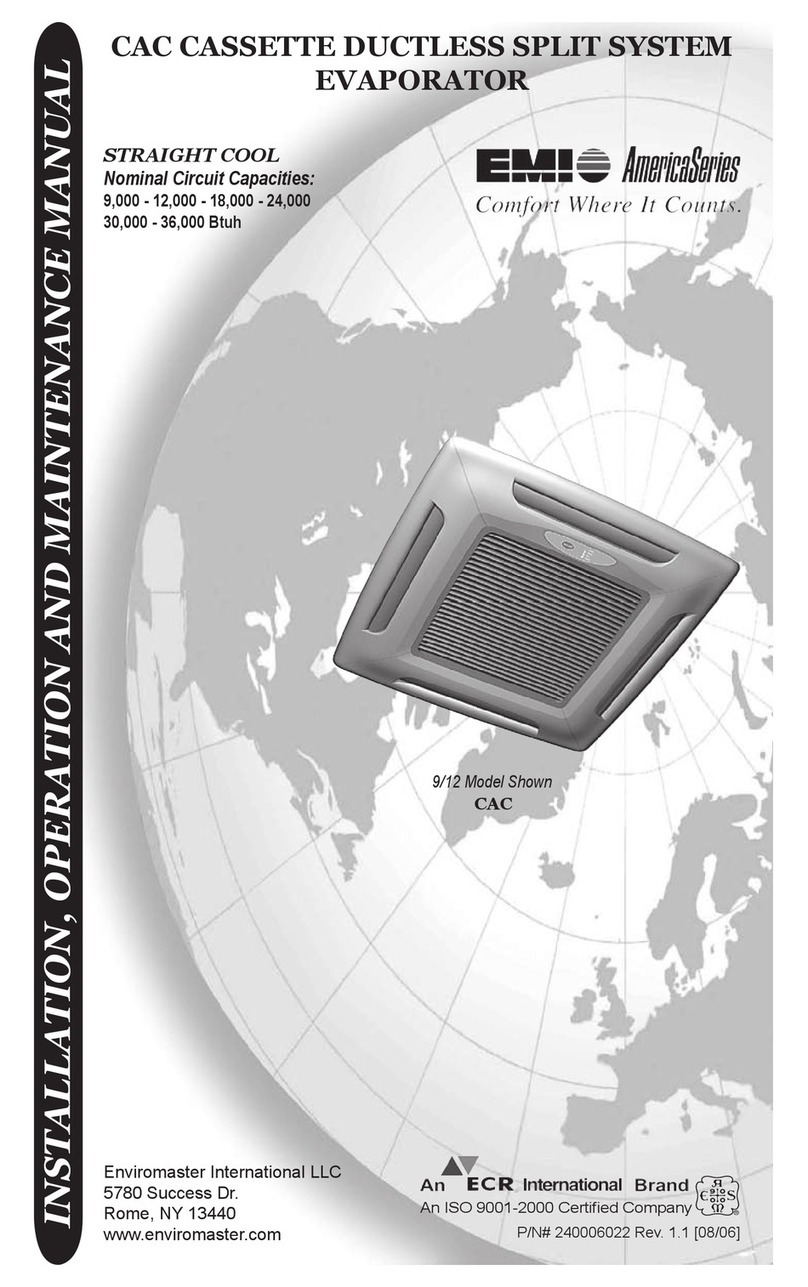
EMI
EMI CAC Installation, operation and maintenance manual
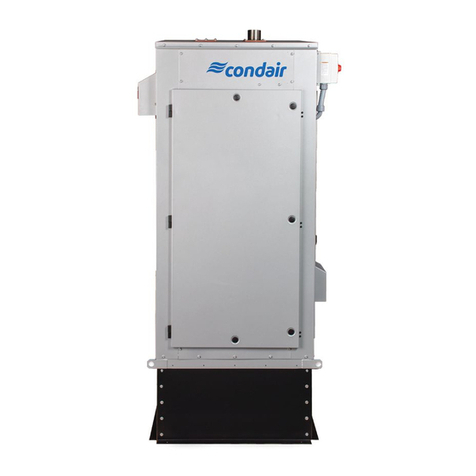
Condair
Condair GS series Installation, operation and maintenance manual
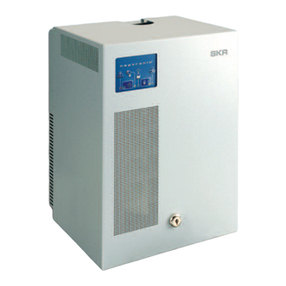
Neptronic
Neptronic SKR Series Installation instructions & user manual

Neptronic
Neptronic SK300 series Installation instructions & user manual
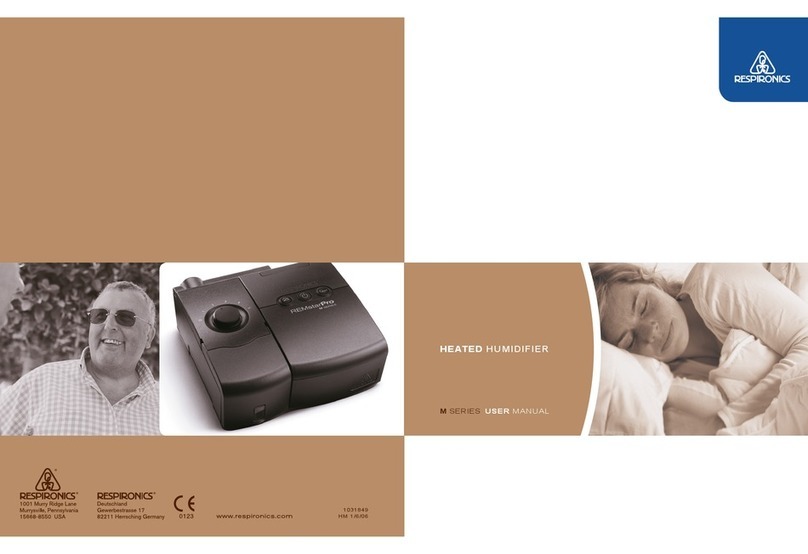
Respironics
Respironics M SeRieS user manual
